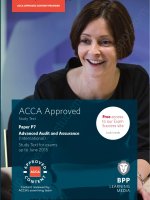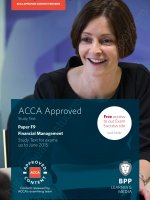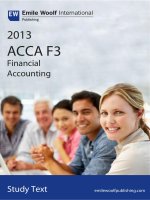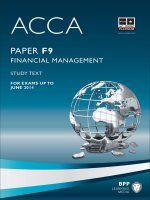ACCA strategic business reporting study text
Bạn đang xem bản rút gọn của tài liệu. Xem và tải ngay bản đầy đủ của tài liệu tại đây (1.01 MB, 24 trang )
ACCA
Strategic Business
Reporting
Study Text
British Library Cataloguing-in-Publication Data
A catalogue record for this book is available from the British Library.
Published by:
Kaplan Publishing UK
Unit 2 The Business Centre
Molly Millars Lane
Wokingham
Berkshire
RG41 2QZ
ISBN: 978-1-78415-823-1
© Kaplan Financial Limited, 2017
The text in this material and any others made available by any Kaplan Group company does not
amount to advice on a particular matter and should not be taken as such. No reliance should be
placed on the content as the basis for any investment or other decision or in connection with any
advice given to third parties. Please consult your appropriate professional adviser as necessary.
Kaplan Publishing Limited, all other Kaplan group companies, the International Accounting Standards
Board, and the IFRS Foundation expressly disclaim all liability to any person in respect of any losses
or other claims, whether direct, indirect, incidental, consequential or otherwise arising in relation to
the use of such materials. Printed and bound in Great Britain.
Acknowledgements
This product includes content from the International Auditing and Assurance Standards Board
(IAASB) and the International Ethics Standards Board of Accountants (IESBA), published by the
International Federation of Accountants (IFAC) in 2015 and is used with permission of IFAC.
This product contains material that is ©Financial Reporting Council Ltd (FRC). Adapted and reproduced
with the kind permission of the Financial Reporting Council. All rights reserved. For further information,
please visit www.frc.org.uk or call +44 (0)20 7492 2300.
This Product includes propriety content of the International Accounting Standards Board which is
overseen by the IFRS Foundation, and is used with the express permission of the IFRS Foundation
under licence. All rights reserved. No part of this publication may be reproduced, stored in a retrieval
system, or transmitted in any form or by any means, electronic, mechanical, photocopying, recording,
or otherwise, without prior written permission of Kaplan Publishing and the IFRS Foundation.
1111111m I F RS"
The IFRS Foundation logo, the IASB logo, the IFRS for SMEs logo, the "Hexagon Device", "IFRS
Foundation", "elFRS", "IAS", "I ASB", "IFRS for SMEs", "IFRS", "I ASs", "IFRSs", "International
Accounting Standards" and "International Financial Reporting Standards", "IFRIC'' and "IFRS
Taxonomy'' are Trade Marks of the IFRS Foundation.
1111111m I F RS"
Trade Marks
The IFRS Foundation logo, the IASB logo, the IFRS for SMEs logo, the "Hexagon Device", "IFRS
Foundation", "elFRS", "IAS", "I ASB", "IFRS for SMEs", "NIIF" IASs" "IFRS", "I FRSs", "International
Accounting Standards", "International Financial Reporting Standards", "I FRI C", "SIC" and "IFRS
Taxonomy".
Further details of the Trade Marks including details of countries where the Trade Marks are registered
or applied for are available from the Foundation on request.
ii
KAPLAN PUBLISHING
Contents
Page
Chapter 1
Frameworks
Chapter 2
The professional and ethical duty of the
accountant
21
Chapter 3
Performance reporting
29
Chapter 4
Revenue
47
Chapter 5
Non-current assets
69
Chapter 6
Agriculture and inventories
113
Chapter 7
Foreign currency in individual financial
statements
125
Chapter 8
Leases
143
Chapter 9
Employee benefits
169
Chapter 10
Share-based payment
195
Chapter 11
Events after the reporting period, provisions and 219
contingencies
Chapter 12
Financial instruments
239
Chapter 13
Tax
301
Chapter 14
Segment reporting
323
Chapter 15
Related parties
335
Chapter 16
Adopting new accounting standards
351
Chapter 17
Small and medium entities
359
Chapter 18
Group accounting – basic groups
365
Chapter 19
Change in a group structure
425
Chapter 20
Group accounting – foreign currency
473
Chapter 21
Group statement of cash flows
501
Chapter 22
Analysis and interpretation
551
KAPLAN PUBLISHING
1
iii
iv
Chapter 23
Current issues
589
Chapter 24
UK GAAP
603
Chapter 25
Questions & Answers
629
Chapter 26
References
685
KAPLAN PUBLISHING
chapter
1
Frameworks
Chapter learning objectives
Upon completion of this chapter you will be able to:
•
Discuss the importance of a conceptual framework in
underpinning the production of accounting standards
•
Discuss the objectives of financial reporting including disclosure
of information that can be used to help assess management’s
stewardship of the entity’s resources and the limitations of
financial reporting
•
Discuss the nature of the qualitative characteristics of useful
financial information
•
Explain the roles of prudence and substance over form in
financial reporting
•
Discuss the high level measurement uncertainty that can make
financial information less relevant
•
Evaluate the decisions made by management on recognition,
derecognition and measurement
•
Critically discuss and apply the definitions of the elements of
financial statements
•
Discuss and apply the definitions of ‘fair value’ measurement
and ‘active market'
•
•
Discuss and apply the ‘fair value hierarchy’
•
Explain the circumstances where an entity may use a valuation
technique.
Discuss and apply the principles of highest and best use, most
advantageous and principal market
1
Frameworks
1 Conceptual Framework for Financial Reporting
Introduction: the need for a conceptual framework
A conceptual framework is a set of theoretical principles and concepts that
underlie the preparation and presentation of financial statements.
If no conceptual framework existed, then it is more likely that accounting
standards would be produced on a haphazard basis as particular issues
and circumstances arose. These accounting standards might be
inconsistent with one another, or perhaps even contradictory.
A strong conceptual framework therefore means that there is a set of
principles in place from which all future accounting standards draw. It also
acts as a reference point for the preparers of financial statements if there is
no adequate accounting standard governing the types of transactions that
an entity enters into (this will be extremely rare).
This section of the text considers the contents of the Conceptual Framework
for Financial Reporting ('the Framework') in more detail.
Background
In 1989 the Board issued the Framework for the Preparation and
Presentation of Financial Statements.
In 2004 a decision was made to work with the US FASB in order to develop
a common framework. The first phase concentrated on two areas:
•
•
The objectives of financial reporting
The qualitative characteristics of useful financial information.
The Board issued the Conceptual Framework for Financial Reporting in
2010. This was the original 1989 version updated for the two areas above.
The joint project with the FASB was then suspended.
2
KAPLAN PUBLISHING
chapter 1
In 2012 the Board decided to revisit the Framework, although this time
without the US FASB. It decided to focus on the following areas:
•
•
•
•
elements of financial statements
measurement
reporting entity
presentation and disclosure.
A Discussion Paper outlining the Board’s thinking on these areas was
published in 2013. The Board received extensive feedback, highlighting the
importance of the Framework to the users and preparers of financial
statements. However, this feedback was varied. Some suggested that the
discussion paper was under-developed; others suggested that it was too
detailed. Devising a Framework that satisfies all parties will most likely
prove impossible.
In response to feedback the Board published an Exposure Draft in 2015.
This is discussed in the ‘Current Issues’ chapter of this Study Text.
The purpose of the Framework
The purpose of the Framework is:
(a) to assist the International Accounting Standards Board (the Board)
when developing new standards
(b) to help national standard setters develop new standards
(c) to provide guidance on issues not covered by IFRS Standards
(d) to assist auditors.
The Board believes that consistency within IFRS Standards, and
comparability between different sets of accounting standards, will help
investors to make informed decisions about whether to buy, sell or hold an
entity's equity and debt instruments.
KAPLAN PUBLISHING
3
Frameworks
The objective of financial reporting
The Framework says that the objective of financial reporting is to provide
information to existing and potential investors, lenders and other creditors
which helps them when making decisions about providing resources to the
reporting entity.
Underlying assumption
The Framework identifies going concern as the underlying assumption
governing the preparation of financial statements.
The going concern basis assumes that the entity will not liquidate or curtail
the scale of its operations.
Qualitative characteristics of useful financial information
The Framework identifies types of information that are useful to the users of
financial statements.
It identifies two fundamental qualitative characteristics of useful financial
information:
(1) Relevance
Information is relevant if it will impact decisions made by its users.
4
–
Relevant information has predictive value or confirmatory value to
a user
–
Relevance is supported by materiality considerations:
– Information is regarded as material if its omission or
misstatement could influence the decisions made by users of
that information
–
An omission or mis-statement could be material due to its
size or nature
–
Materiality is an entity-specific consideration and so the
Framework does not specify a minimum threshold.
KAPLAN PUBLISHING
chapter 1
(2) Faithful representation
For financial information to be faithfully presented, it must be:
–
complete
–
neutral
–
free from error.
Therefore, it must comprise information necessary for a proper
understanding, it must be without bias or manipulation and clearly
described.
In addition to the two fundamental qualitative characteristics, there are four
enhancing qualitative characteristics of useful financial information. These
should be maximised when possible:
(1) Comparability
Information is more useful if it can be compared with similar information
about other entities, or even the same entity over different time periods.
Consistency of presentation helps to achieve comparability of financial
information. Permitting different accounting treatments for similar items
is likely to reduce comparability.
(2) Verifiability
The Framework explains that verifiability means 'that different,
knowledgeable and independent observers could reach
consensus, although not necessarily complete agreement, that a
particular presentation of an item or items is a faithful
representation' (Framework, para QC26).
Verifiability of financial information provides assurance to users
regarding its credibility and reliability.
(3) Timeliness
Information should be made available to users within a timescale which
is likely to influence their decisions. Older information is less useful.
(4) Understandability
Information should be presented clearly and concisely.
KAPLAN PUBLISHING
5
Frameworks
The cost constraint
It is important that the costs incurred in reporting financial information are
justified by the benefits that the information brings to its users.
The elements of financial statements
The financial effects of a transaction can be grouped into broad classes,
known as the elements.
According to the Framework, there are five elements of financial statements:
Assets – resources controlled by an entity from a past event that will lead to
a probable inflow of economic benefits.
Liabilities – obligations of an entity arising from a past event that will lead to
a probable outflow of economic resources.
Equity – the residual net assets of an entity after deducting its liabilities.
Incomes – increases in economic benefits during the accounting period.
Expenses – decreases in economic benefits during the accounting period.
Criticisms of the definitions of the elements
The following criticisms could be made of these definitions:
6
•
The definitions are inconsistently applied across the range of IFRS and
IAS Standards
•
The concept of ‘control’ is not clearly defined and proves difficult to
apply
•
There is a lack of guidance about the meaning of an ‘economic
resource’
•
The notion of ‘expectation’ is vague. Does it refer to the probability of
an inflow/outflow or to a mathematical ‘expected value’?
•
The definitions offer insufficient guidance on the difference between
liabilities and equity. Further guidance here would benefit users,
particularly when applying these concepts to financial instruments.
KAPLAN PUBLISHING
chapter 1
Recognition of the elements of financial statements
The Framework says that an item should be recognised in the financial
statements if:
•
•
•
it meets the definition of an element
it is probable that future economic benefits will flow to or from the entity
the item can be measured reliably.
Measurement of the elements of financial statements
Measurement is the process of determining the amount at which the
elements should be recognised and carried at in the statement of financial
position and the statement of profit or loss and other comprehensive
income.
The Framework identifies four possible measurement bases:
Historical cost
Assets are recorded at the amount paid to acquire them.
Liabilities are recorded at the value of the proceeds received, or at the
amount expected to be paid to satisfy the liability.
Current cost
Assets are carried at their current purchase price.
Liabilities are carried at the amount currently required to settle them.
Realisable value
Assets are carried at the amount that would be received in an orderly
disposal.
Liabilities are carried at the amount to be paid to satisfy them in the normal
course of business.
Present value
Assets are carried at the present value of the future cash flows that the item
will generate.
Liabilities are carried at the present value of the future cash outflows
required to settle them.
KAPLAN PUBLISHING
7
Frameworks
Prudence
Older versions of the Framework referred to the importance of prudence
when producing financial reports.
Being prudent means exercising caution. In corporate reporting, this is often
interpreted as meaning that entities should not overstate their assets or
understate their liabilities.
The Board removed prudence from the Framework because they thought it
was inconsistent with neutrality. This is because reducing assets in one
period is likely to lead to the over-statement of financial performance in the
next period.
The Board are considering reintroducing an explicit reference to prudence
into the Framework.
Criticisms of financial reporting
The Framework relates to financial reporting. However, the very nature of
financial reporting has become increasingly criticised in recent years. This
has led to the emergence of forms of non-financial reporting, which are
discussed later in this text.
Some of the criticisms of financial reporting are discussed below.
Historical information
The statement of profit or loss shows the performance of the entity over the
past reporting period. This offers little insight into the future. Moreover by the
time financial statements are published, the information presented will be
several months out of date.
Unrecognised assets and liabilities
Some assets and liabilities are not recognised in financial statements
prepared using IFRS Standards, such as internally generated goodwill. This
means that no asset is recognised in respect of the company’s reputation or
employee skills even though these may play a pivotal role in its success.
Clutter
Financial reports have been criticised in recent years for becoming
increasingly cluttered as a result of extensive disclosure requirements.
These disclosures can be very generic and they make harder for the users
to find relevant information.
8
KAPLAN PUBLISHING
chapter 1
Financial/non-financial information
Current and past profits and cash flows are not the only determinate of future
success. Long-term success is also dependent on how an entity is
governed, the risks to which it is exposed and how well these are managed,
and whether its business activities are sustainable into the medium and
long-term. Financial statements prepared in accordance with IFRS
Standards say little about these areas.
Estimates
Financial reporting uses many estimates (e.g. depreciation rates).
Estimates are subjective and could be manipulated in order to achieve
particular profit targets. The subjective nature of estimates reduces
comparability between companies.
The statement of cash flows somewhat compensates for the impact of
accounting estimates. However, the cash position of an entity can also be
window-dressed (such as by delaying payments to suppliers).
Professional judgement
Financial reporting requires judgement. For example, judgement is required
by lessors when classifying a lease as a finance lease or an operating
lease. Subjective decisions reduce comparability and increase the risk of
bias.
Use of historical cost
Some accounting standards, such as IAS 16 Property, Plant and
Equipment, permit assets to be measured at historical cost. In times of
rising prices, the statement of profit or loss will not show a sustainable level
of profit.
Policy choices
Some standards, such as IAS 16 Property, Plant and Equipment and IAS 40
Investment Properties, allow entities to choose between cost and fair value
models. This makes it harder to investors to compare financial statements
on a like-for-like basis.
KAPLAN PUBLISHING
9
Frameworks
2 IFRS 13 Fair Value Measurement
Introduction
The objective of IFRS 13 is to provide a single source of guidance for fair
value measurement where it is required by a reporting standard, rather than
it being spread throughout several reporting standards.
Many accounting standards require or allow items to be measured at fair
value. Some examples from your prior studies include:
•
IAS 16 Property, Plant and Equipment, which allows entities to
measure property, plant and equipment at fair value
•
IFRS 3 Business Combinations, which requires the identifiable net
assets of a subsidiary to be measured at fair value at the acquisition
date.
Scope
IFRS 13 does not apply to:
•
•
share-based payment transactions (IFRS 2 Share-based Payments)
leases (IFRS 16 Leases).
The definition of fair value
Fair value is defined as 'the price that would be received to sell an
asset or paid to transfer a liability in an orderly transaction between
market participants at the measurement date' (IFRS 13, para 9).
Market participants are knowledgeable, third parties. When pricing an asset
or a liability, they would take into account:
•
•
•
Condition
Location
Restrictions on use.
It should be assumed that market participants are not forced into
transactions (i.e. they are not suffering from cash flow shortages).
IFRS 13 notes that there are various approaches to determining the fair
value of an asset or liability:
•
•
•
10
Market approaches (valuations based on recent sales prices)
Cost approaches (valuations based on replacement cost)
Income approaches (valuations based on financial forecasts).
KAPLAN PUBLISHING
chapter 1
Whatever approach is taken, the aim is always the same – to estimate the
price that would be transferred in a transaction with a market participant.
The price
Fair value is a market-based measurement, not one that is entity specific.
As such, when determining the price at which an asset would be sold (or the
price paid to transfer a liability), observable data from active markets should
be used where possible.
An active market is a market where transactions for the asset or liability
occur frequently.
IFRS 13 classifies inputs into valuation techniques into three levels.
•
•
•
Level 1 inputs are quoted prices for identical assets in active markets.
Level 2 inputs are observable prices that are not level 1 inputs. This
may include:
–
Quoted prices for similar assets in active markets
–
Quoted prices for identical assets in less active markets
–
Observable inputs that are not prices (such as interest rates).
Level 3 inputs are unobservable. This could include cash or profit
forecasts using an entity’s own data.
A significant adjustment to a level 2 input would lead to it being
categorised as a level 3 input.
Priority is given to level 1 inputs. The lowest priority is given to level 3 inputs.
KAPLAN PUBLISHING
11
Frameworks
Inputs to determine fair value
IFRS 13 gives the following examples of inputs used to determine fair
value:
Asset
Example
Level 1
Equity shares in a listed
entity
Unadjusted quoted prices in an
active market.
Level 2
Building held and used
Price per square metre for the
building from observable
market data, such as observed
transactions for similar
buildings in similar locations.
Level 3
Cash-generating unit
Profit or cash flow forecast
using own data.
Test you understanding 1 – Baklava
Baklava has an investment property that is measured at fair value. This
property is rented out on short-term leases.
The directors wish to fair value the property by estimating the present
value of the net cash flows that the property will generate for Baklava.
They argue that this best reflects the way in which the building will
generate economic benefits for Baklava.
The building is unique, although there have been many sales of similar
buildings in the local area.
Required:
Discuss whether the valuation technique suggested by the
directors complies with International Financial Reporting
Standards.
12
KAPLAN PUBLISHING
chapter 1
Markets
The price received when an asset is sold (or paid when a liability is
transferred) may differ depending on the specific market where the
transaction occurs.
Principal market
IFRS 13 says that fair value should be measured by reference to the
principal market.
The principal market is the market with the greatest activity for the asset or
liability being measured.
The entity must be able to access the principal market at the measurement
date. This means that the principal market for the same asset can differ
between entities.
Most advantageous market
If there is no principal market, then fair value is measured by reference to
prices in the most advantageous market.
The most advantageous market is the one that maximises the net amount
received from selling an asset (or minimises the amount paid to transfer a
liability).
Transaction costs (such as legal and broker fees) will play a role in deciding
which market is most advantageous. However, fair value is not adjusted for
transaction costs because they are a characteristic of the market, rather
than the asset.
Test your understanding 2 – Markets
An asset is sold in two different active markets at different prices. An
entity enters into transactions in both markets and can access the price in
those markets for the asset at the measurement date as follows:
Price
Transaction costs
Transport costs
Net price received
KAPLAN PUBLISHING
Market 1
$
26
(3)
(2)
–––––
21
–––––
Market 2
$
25
(1)
(2)
–––––
22
–––––
13
Frameworks
What is the fair value of the asset if:
(a) market 1 is the principal market for the asset?
(b) no principal market can be determined?
Non-financial assets
What is a non-financial asset?
The difference between financial and non-financial assets is covered in
detail in Chapter 11. Financial assets include:
•
•
Contractual rights to receive cash (such as receivables)
Investments in equity shares.
Non-financial assets include:
•
•
Property, plant and equipment
Intangible assets.
The fair value of a non-financial asset
IFRS 13 says that the fair value of a non-financial asset should be based on
its highest and best use.
The highest and best use of an asset is the use that a market participant
would adopt in order to maximise its value.
The current use of a non-financial asset can be assumed to be the highest
and best use, unless evidence exists to the contrary.
The highest and best use should take into account uses that are:
•
•
•
Physically possible
Legally permissible
Financially feasible.
IFRS 13 says a use can be legally permissible even if it is not legally
approved.
14
KAPLAN PUBLISHING
chapter 1
Test you understanding 3 – Five Quarters
Five Quarters has purchased 100% of the ordinary shares of Three
Halves and is trying to determine the fair value of the net assets at the
acquisition date.
Three Halves owns land that is currently developed for industrial use. The
fair value of the land if used in a manufacturing operation is $5 million.
Many nearby plots of land have been developed for residential use (as
high-rise apartment buildings). The land owned by Three Halves does not
have planning permission for residential use, although permission has
been granted for similar plots of land. The fair value of Three Halves’ land
as a vacant site for residential development is $6 million. However,
transformation costs of $0.3 million would need to be incurred to get the
land into this condition.
Required:
How should the fair value of the land be determined?
Investor perspective
Below is an extract from a disclosure note about the fair value of an
entity’s financial assets and liabilities:
Fair value of financial instruments
Financial asset – traded
equities
Financial liability –
contingent consideration
Level 1
$m
110
Level 2
$m
Level 3
$m
33
The fair values of the traded equities have been determined by
reference to market price quotations.
The fair value of contingent consideration is estimated based on
the forecast future performance of the acquired business over a
timeframe determined as part of the acquisition agreement,
discounted as appropriate. Key assumptions include growth
rates, expected selling volumes and prices and direct costs
during the period.
KAPLAN PUBLISHING
15
Frameworks
This disclosure informs investors that the fair value of investments in
equities has been derived using level 1 inputs (quoted prices for identical
assets in active markets). This measurement involves no judgement,
eliminating the risk of bias, and can be verified by knowledgeable third
parties.
In contrast, the disclosure informs investors that the fair value of the
contingent liability has been derived using level 3 inputs. This
measurement involves a high level of judgement, increasing the risk of
management bias. It also makes it more likely that the amount eventually
paid by the entity will differ materially from the year-end carrying amount.
For this reason, the disclosure provides additional information about how
management have estimated the fair value of the liability, so that the
investors can assess the adequacy of the methodology used and reach a
conclusion as to whether the level of measurement uncertainty is
acceptable to them.
Due to the level of risk, some investors may decide to sell their shares in
an entity if its fair value measurements are overly reliant on level 3 inputs.
16
KAPLAN PUBLISHING
chapter 1
Chapter summary
KAPLAN PUBLISHING
17
Frameworks
Test your understanding answers
Test you understanding 1 – Baklava
The directors’ estimate of the future net cash flows that the building will
generate is a level 3 input. IFRS 13 gives lowest priority to level 3 inputs.
These should not be used if a level 1 or level 2 input exists.
Observable data about the recent sales prices of similar properties is a
level 2 input. The fair value of the building should therefore be based on
these prices, with adjustments made as necessary to reflect the specific
location and condition of Baklava’s building.
Test your understanding 2 – Markets
(a) If Market 1 is the principal market then the fair value would be
measured using the price that would be received in that market less
transport costs. The fair value would therefore be $24 ($26 – $2).
Transaction costs are ignored as they are not a characteristic of the
asset.
(b) If neither market is the principal market for the asset then the fair
value would be measured in the most advantageous market. The
most advantageous market is the market that maximises the net
amount received from the sale.
The net amount received in Market 2 ($22) is higher than the net
amount received in Market 1 ($21). Market 2 is therefore the most
advantageous market. This results in a fair value measurement of
$23 ($25 – $2). IFRS 13 specifies that transaction costs play a role
when determining which market is most advantageous but that they
are not factored into the fair value measurement itself.
18
KAPLAN PUBLISHING
chapter 1
Test you understanding 3 – Five Quarters
Land is a non-financial asset. IFRS 13 says that the fair value of a nonfinancial asset should be based on its highest and best use. This is
presumed to be its current use, unless evidence exists to the contrary.
The current use of the asset would suggest a fair value of $5 million.
However, there is evidence that market participants would be interested
in developing the land for residential use.
Residential use of the land is not legally prohibited. Similar plots of land
have been granted planning permission, so it is likely that this particular
plot of land will also be granted planning permission.
If used for residential purposes, the fair value of the land would be $5.7
million ($6m – $0.3m).
It would seem that the land’s highest and best use is for residential
development. Its fair value is therefore $5.7 million.
KAPLAN PUBLISHING
19
Frameworks
20
KAPLAN PUBLISHING









